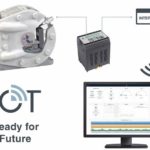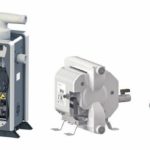Modern plants are highly complex systems. Many plant parameters are already being monitored today – however pumps are usually the exception. Even though pumps are frequently the heart of a plant and thus a crucial element in the process chain. Consequently, failures can result in considerable financial losses. With regard to maintenance times or a replacement, to date, users have been compelled to rely on empirical values. For pneumatic double diaphragm pumps in particular, previously it has scarcely been possible to collect production data. Pump specialist Timmer, based in Neuenkirchen, Germany, has met this challenge with its Tim-IoT solution. It enables read-out and extensive statistical analysis of pump data. The Tim-IoT system structure is quite simple: first, the pump must have an intelligent sensor; since
1 May 2021, an intelligent sensor has been integrated in most of Timmer’s double diaphragm pumps, as standard equipment. Then the sensor is linked to the Tim-IoT Smartbox, which transmits all data to the cloud. The data are visualised and analysed on freely selectable end devices, such as PC, smart phone or tablet. Such a simple structure, yet such complex technology inside. The Timmer solution works with particular precision: a measuring point is set, i. e. information is generated, every one-hundredth of a second. Unlike the processes with big data, where frequently all of these large data volumes are transmitted, Timmer uses edge computing. First the system analyses and bundles the data from the pump in the Tim-IoT Smartbox, and only thereafter it sends the most important information to the cloud. This saves resources, since data transfer is significantly reduced. However the advantages of big data volumes are not lost when edge computing is used, on the contrary: the flexibility of the solution also allows users access to extensive status reports by means of so-called snapshots. Snapshots generate a 20-second recording with approximately 2,000 measuring points. If a fault occurs or if a threshold is exceeded, the system even saves all the measured data retroactively and notifies the plant operator. By virtue of this function, users can analyse deviations with one-hundredth of a second precision.
Custom control
Precisely when a notification should occur, and precisely which parameters require special observation, can be adjusted individually via the user interface. Plant operators are in a position to specify a number of tolerances and causalities, and add notifications to them if certain values are exceeded or are not reached. For example, such values include precise thresholds for a number of parameters – including, pressure, frequency, flow and frequency ratio. The more values that are defined, the closer the mesh of the monitoring grid for the pump’s run behaviour. If a value exceeds or does not reach the specified tolerance, the plant operator receives a notification immediately. In addition, Tim-IoT has other useful tools, such as maintenance planning, a maintenance calendar as well as user-friendly management of service reports and pump-specific documentation. Data protection was one of Timmer’s design priorities for its standalone solution, this is also explicitly demanded by the industry. This aspect is considered in the data transmission possibility via separate LTE router, which works independently of the company network, and it is also taken into account in the processes overall: the system receives only the data of the pump; it has no view whatsoever of other parameters or processes beyond the pump data. Using the pure pump data can indeed provide indications that faults may be present in the process chain, due to the changing information. But only the user himself has the big picture required for understanding and interpreting the overall work chain. Nevertheless, even the pure pump information alone can be decisive for detecting errors and thus preventing production downtimes, for instance.
Reliable real-time monitoring
With meaningful data, plant operators can more efficiently organise processes in practice and make well-informed decisions. Parameters, such as pump frequency, number of strokes, or pressure curves, are permanently visible. Predictions concerning wear and scheduling of repair measures become significantly more precise – this precision ensures optimal use of the pumps over their entire service life. Moreover, statistical analysis of production data facilitates calculation of operating costs and optimisation of plant use. Frequently plant operators service all pumps at the same time, even though some of the pumps have only reached a fraction of their service life – over time this can amount to a significant but needless expense. In addition, predictive maintenance minimises maintenance downtime and damage, yet it increases process stability and machine availability. By means of health data, such as average frequency range, stroke count and operating hours, precise conclusions can be drawn regarding necessary dimensioning of the pumps. These values must always be considered in relation to each other. For example, if the pump is relatively new, but is constantly running in a very high frequency range, then not only is service life reduced, this is also a high-probability indicator that a larger pump would be better suited for the process. Most recently the corona pandemic has clearly shown that the old model – yet still frequently used in practice – of hand-written records of pump and maintenance information on a warning tape, can cause real problems. Here is a specific example: a Timmer customer services his pumps every six months according to that customer’s empirical values obtained over many years. However, due to the corona pandemic and its economic consequences the customer’s plant was not always used to capacity and even ceased production for several days. This renders the customer’s reference data obsolete – all of the empirical values worked out over the years were irrelevant within a few months. The plant operator does indeed know that the pump was serviced six months ago. But he does not know how many hours it has been in use since then, due to the irregular operation. This example and other practical cases illustrate the benefits that monitoring has to offer: if the pump is process-relevant, then it must be monitored for safe and economical operation.
Timmer GmbH, Neuenkirchen










